Home » Other Articles » Tuesday Treasures Index » Tuesday Treasures - October 2022 - Tuesday Treasures - October 2022
Tuesday Treasures - October 2022
TUESDAY 24 OCTOBER
Children’s Education through Railway Publications
In three previous blogs we have recorded how the Great Western Railway produced children’s books and games that provided their image and gave varying degrees of educational content. The Great Western Trust Collection, holds a wide variety of that material, both railway produced and that of contemporary publishers. Our Blog today focuses upon a popular Boy’s Annual that included, but was not confined just to, railway subjects.

Our chosen example is a good example of the type of annual and its contents that appealed to boys. This is the cover of the Boy’s Own Annual published by Purnell Books in 1968 for the 1969 season, no doubt maybe for aunties and uncles or grandparents to give to a beloved youngster?
The Annual was a spin-off from the Boy’s Own Paper which was published from 1879 to 1967. Purnell had taken over the Paper in 1963. The Annual continued until 1975.
What is of course immediately eye catching on the cover of our copy is the artist’s impression of ‘Britain's 150 MPH JET BULLET Train’…!! Complete of course with the reverse arrow logo of British Rail too. The artist has evidently taken inspiration from the Japanese Shinkansen bullet trains introduced in 1964. But why include the power station cooling towers?
Even more illuminating is that a very celebrated railway specialist author, no less than Cecil J Allen provided the ‘exclusive’ article focusing upon worldwide train speed developments and he exposes the fact that the BR Technical Research Department at Derby, were already experimenting with a model of this very ‘Jet propelled train’!!
To be fair however, he does advise caution in any reader expecting an early full scale version!
The Annual includes a wide range of boy's interest articles beyond railways, even to build your very own transistor amplifier. To prove how risky it was to predict or dismiss various future achievements, an article by the late, great Patrick Moore – of ‘The Sky at Night’ famed series on BBCTV – on ‘Moon Rockets’ stated that: “The Americans have announced that they mean to send a man to the Moon before 1970, but in my view this is rather over-optimistic.”
It was closer than Patrick Moore imagined, but mankind's visits to the Moon were short-lived, taking place between 1969 and 1972. BR's 150mph Jet Train was similarly short-lived, being operational from 1972 to 1976. But it did 150mph, and at Didcot too! Our photograph of it going through Didcot station at 150mph in August 1975 even includes the power station cooling towers, so the cover of Boy's Own was prophetic in that detail as well!.
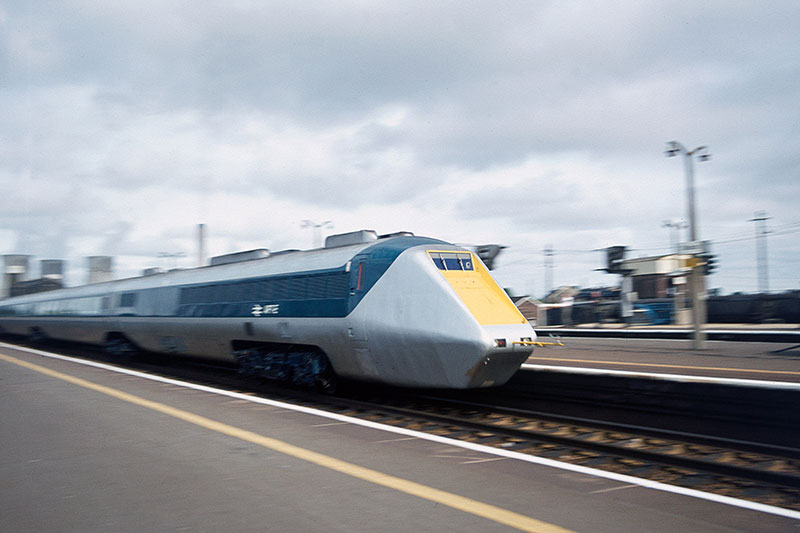
The APT-E (Advanced Passenger Train Experimental) was indeed a Jet Train as it was powered by gas turbine engines. In 1976 it was consigned to the National Railway Museum, where it resides at Locomotion in Shildon. Development continued on the APT-P (Advanced Passenger Train Prototype) which was electric powered, but never entered passenger service successfully.
TUESDAY 18 OCTOBER
Back to Basics
Visitors to the Great Western Trust Museum are often surprised by the measures that the GWR took to prevent pilferage. It is understandable that expensive pieces such as furniture, glass and silverware should be marked with the old Company's crest or initials but here we show examples of two far more fundamental items, namely a chamber pot and toilet paper.
In the days before en-suite bathrooms became the norm in hotel rooms, chamber pots were provided for the use of guests who preferred not to walk down the corridor to the nearest toilet in the middle of the night.
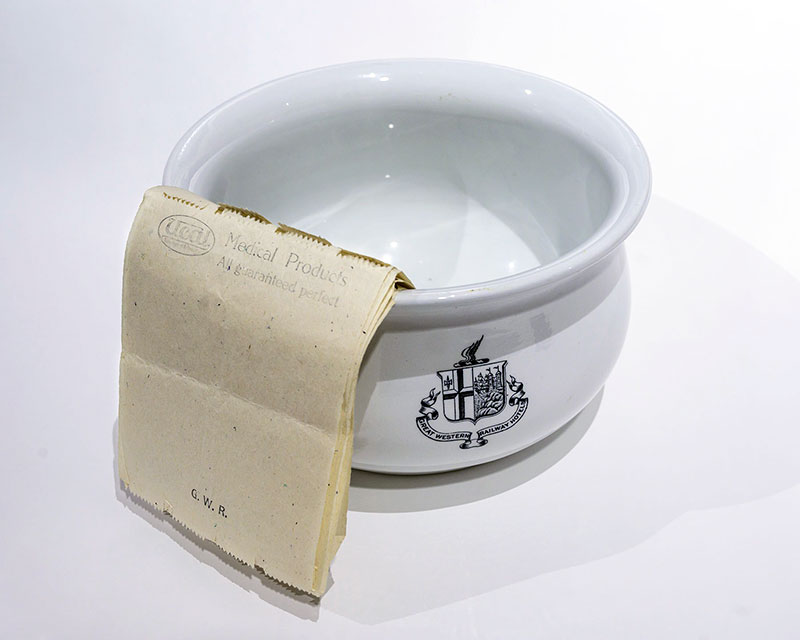
This superb example of chinaware dates from around 1930. It was made by Minton in Stoke-on-Trent and was generously donated by a gentleman from Bradley Stoke in 2020. He obtained it through an auction at the Royal Station Hotel in Newcastle-upon-Tyne some years ago, for the princely sum of £1.
The Minton company was founded by Thomas Minton in 1793 and was a major producer of Staffordshire pottery. It remained an independent business until 1968.
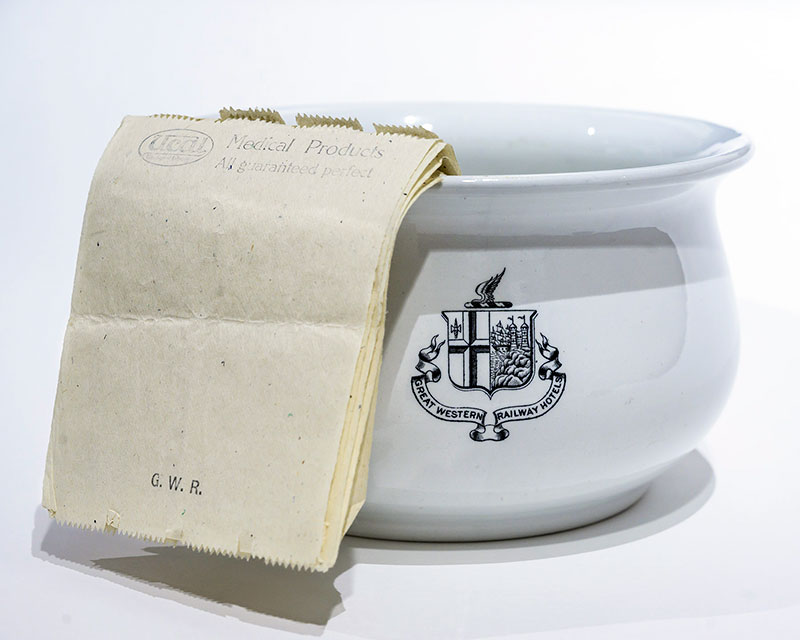
We have one other, similar pot in the Great Western Trust collection, although they are quite rare items, particularly in mint condition such as this example.
The eight sheets of GWR toilet paper, however, may very well be unique survivors; few things are designed to be so ephemeral and it is testament to the robustness of the product that they have lasted so long.
The “Ucal” symbol at the top of the sheet identifies the manufacturer as the United Chemists’ Association Limited. The company was established in 1904 when a group of pharmacies formed an association to manufacture their own products. Its production was centred on Cheltenham, so we thought it would be a customer of the railway to distribute the goods. Sure enough, and rather disappointingly, the July 1928 edition of Great Western Railway Magazine in its ‘From People We Intend to Please’ column prints this letter of complaint:
“In these days of intensive competition between road and rail transport, I should like to call your attention to one of the main causes of the road gaining the trade, i.e. delay on the railway.
“On May 9, the United Chemists’ Association handed to the Great Western Railway at Cheltenham a case of medicines for me. The GWR, Cheltenham, kept this case till the 10th before sending it off. I did not get the case delivered in my shop until the afternoon of the 14th, i.e., after the weekend was over, consequently losing much trade through the goods for which I was asked being on railway instead of in my shop.
“Do you wonder that the retailer always says wherever possible send by road? At the same time I think there ought to be an investigation into a delay like this. Five days to bring a case of medicines 90 miles, on the same railway all the time!" – From Mr. W. Varley, MPS, 8, East Reach, Taunton, to the General Manager.
TUESDAY 11 OCTOBER
Banbury Fair
October is the English traditional season for ‘Fairs’ or ‘Wakes’, and in a recent blog we covered Oxford’s St Giles Fair. Today we think it justified to focus upon the equally long established Banbury Fair, which in 1948 took place on Thursday 14 October. We know that because of the handbill we illustrate from our Great Western Trust Collection.

Just like that for the Oxford event, BRWR wanted to benefit from the expected high train travel demand to attend it. So for stations including those very modest ‘Halts’, up to 30 miles distant from Banbury, BRWR offered First and Third Class cheap day return tickets and even special late return trains south for stations to Oxford and north to Leamington Spa.
This modest handbill is a survivor of no less than the 5,700 printed and distributed for stations in the London, Birmingham, Worcester and Gloucester Divisions.
Most likely, many of the entertainments offered at Banbury were those recently at Oxford, as towns in the Cotswolds and surrounding areas held such events on a rolling programme, one example being Chipping Norton. We haven’t yet found records of those entertainers needing their own special train service transport, but today’s Chipping Norton fair would certainly have taxed them, with quite massive elevated rides now only transportable by dedicated road vehicles.
One fact is sadly now well established however, in that our current railway franchises shy away from providing any extra services for such events, preferring to cram folk into existing train-sets!
TUESDAY 4 OCTOBER
The Influence of GWR Publicity
Our Blogs have on many occasions reflected the importance the GWR and BRWR placed upon publicity in all its varied forms. This blog illustrates from the many examples held in the Great Western Trust collection, a give-away item that by our standards is quite extraordinary in its design though it yet again reflects the social norms of its day, around the 1930s, when public smoking was entirely accepted, and railways dedicated smoking compartments and carriages to that clientele.
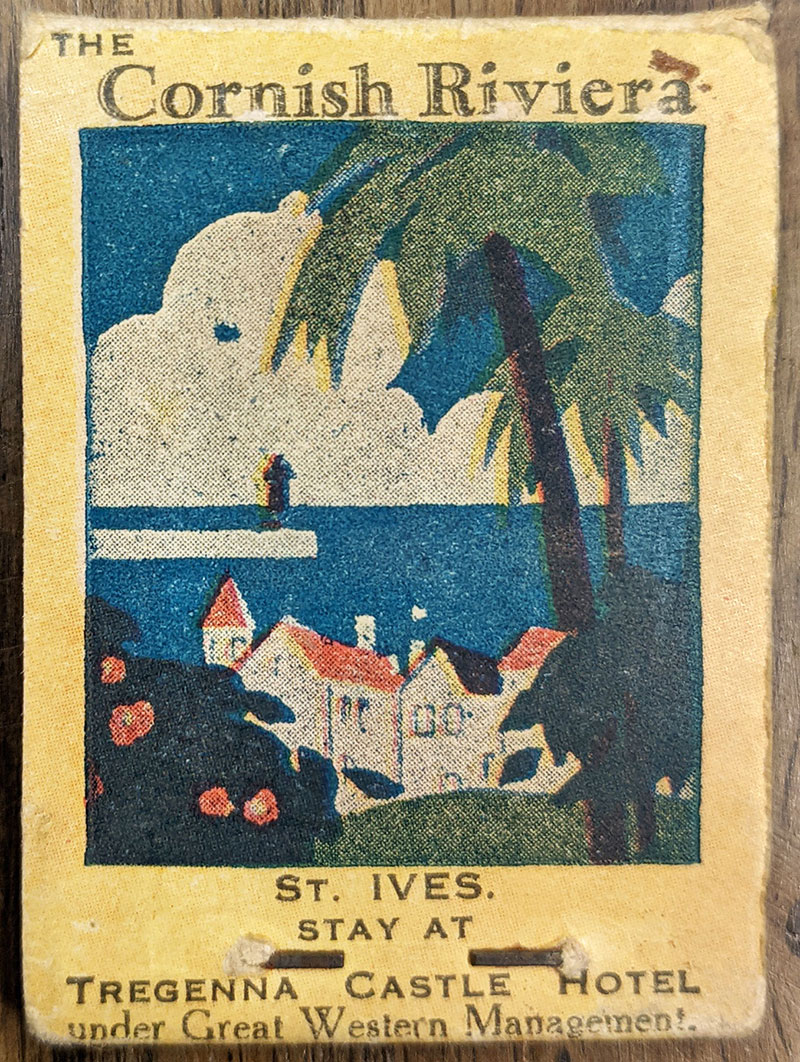
Known as Bookmatch boxes, produced by Bryant & May Co amongst others, the Trust holds many examples for public use, especially at their hotels, and even for their staff, which we will cover in another dedicated blog. This example illustrated however, is clearly for those fortunate individuals who travelled on the GWR’s most famous express, the 10:30 Limited, or Cornish Riviera Express from Paddington to Penzance via Plymouth.
As a short explanation, the title ‘10:30 Limited’ reflected its popularity. It always left at 10:30 am from No1 Platform at Paddington, its most prestigious departure platform, adjacent to the senior officers’ rooms and other key facilities including the Royal Waiting Room, and it was ‘Limited’ as the train then departing at that 10:30 time, had limited, pre-booked seating. It was so popular that on many occasions, multiple relief trains had to be run to cope with the demand!
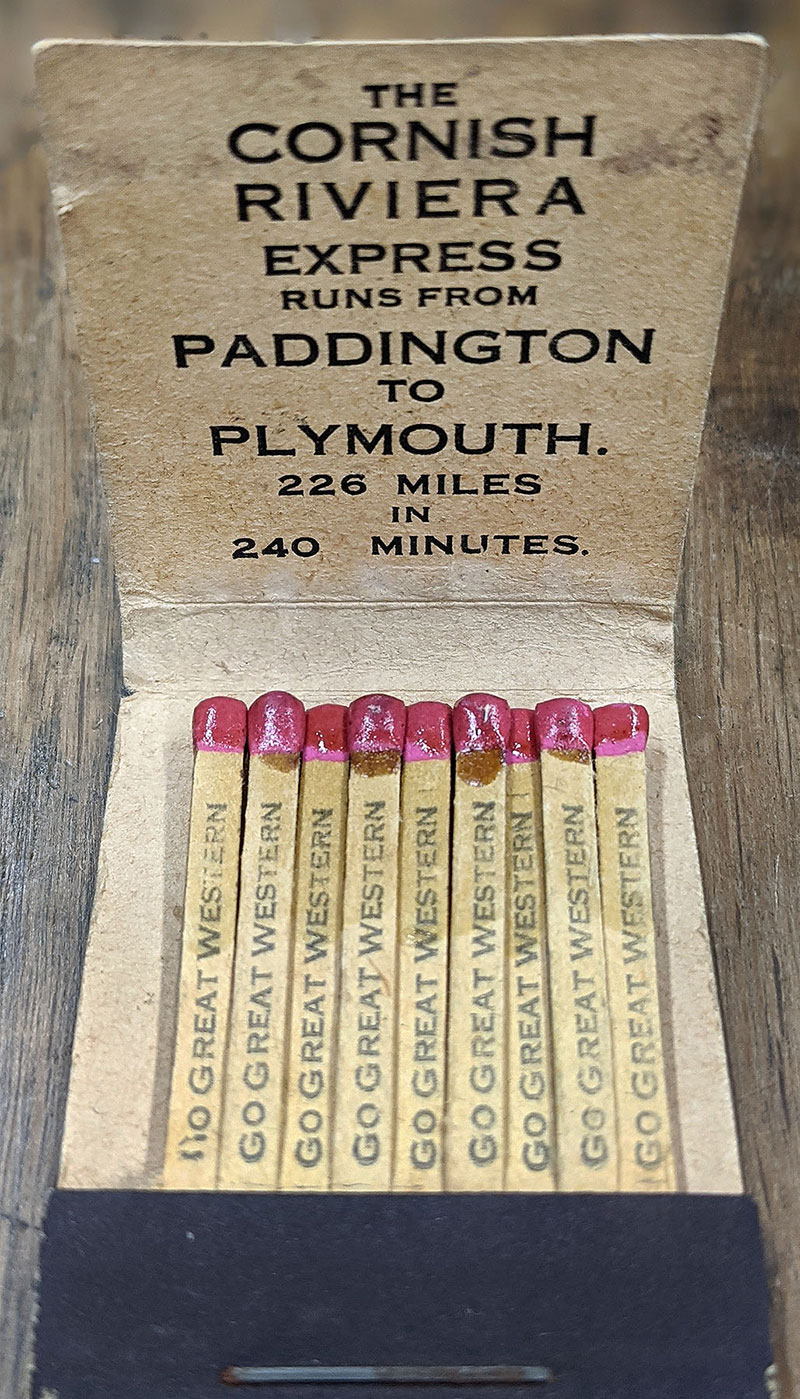
Now to the bookmatch box. Its cover image is a King Class Loco, always reserved if available for this very important and heavily laden train. The rear cover has a further advert on the GWR’s hotel at Tregenna Castle St Ives, and its central section is quite extraordinary! Here we have another GWR ‘slogan’ ‘Go Great Western’ but printed on every match!!
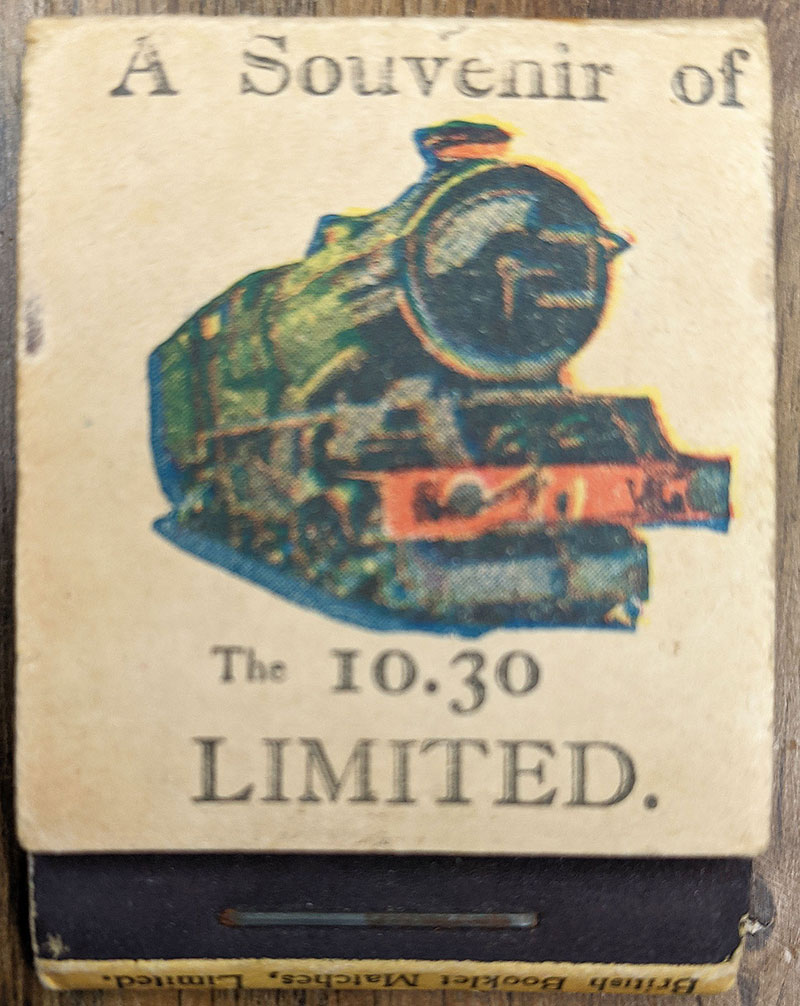
Such bookmatch boxes were to be found on the dining car tables on a special EPNS holder.
As an indication of the popularity of smoking 100 years ago, on 4 October 1920, the GWR issued a circular to all stations laying down that all trains had to be formed with 50% smoking accommodation. From 6 October 1930, the GWR decided that special compartments would no longer be labelled as being reserved for smokers and that smoking would be allowed in all carriages except those designated by a new type of triangular ‘No Smoking’ label. This had the effect of increasing the proportion of smoking accommodation and the GWR then started to label one in four compartments in nearly 10,000 vehicles as ‘No Smoking’.
Smoking on trains may no longer be legal nor desired these days, but even so, the exploitation of past smoking norms, to further GWR's publicity is at the very least, a remarkable demonstration of their drive and confidence to influence their customers in any way possible!
Didcot Railway Centre Newsletter
Stay up to date with events and what's going on at Didcot Railway Centre.
You may unsubscribe at any time. We do not share your data with 3rd parties.